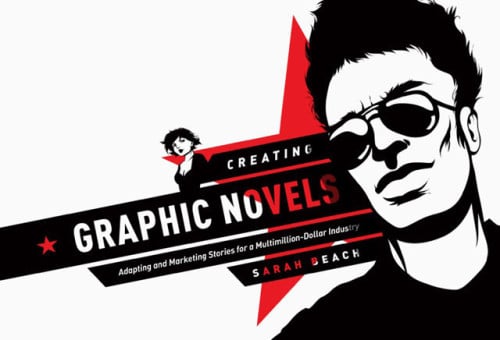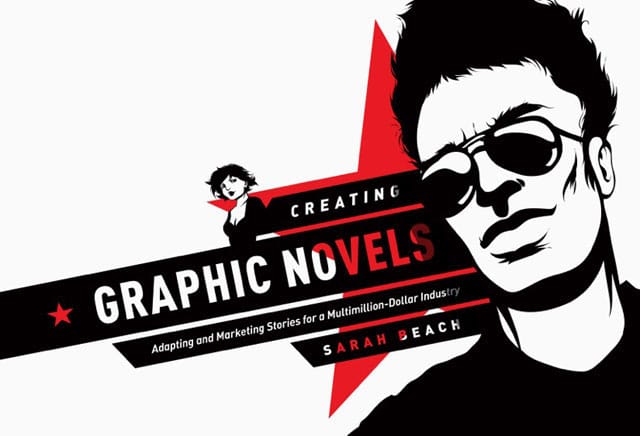
Our thanks to the irrepressible Sarah Beach, a friend of Blake and STC! Sarah worked many years as a researcher at Jeopardy, and wrote The Scribbler’s Guide to the Land of Myth, a book on mythic motifs for writers. You can visit the blog for that book or her more general website. But the big news is Sarah’s new book, Creating Graphic Novels: Adapting and Marketing Stories for a Multimillion-Dollar Industry, which Blake influenced. Read on!
Having the opportunity to write this guest blog for Save the Cat! is a special thing for me. I began planning the project that became Creating Graphic Novels back in early 2009. In fact, in February of that year, I met one-on-one with Blake to strategize. His genuine enthusiasm for other people’s projects was always such an encouragement. And I have to say that a good deal of the final book owes its voice to Blake. He shared my interest in storytelling in different media, how the form might change the way one approached the storytelling. And that was what this project was about: turning screenplays into graphic novels.
I had been hearing for several years about screenwriters who went into meetings with not-quite-mainstream scripts. Many of them would have good meetings, and then have the encounter close with a reluctant comment from the producer — something along the lines of “I wish there was a book or graphic novel of this, so I could see what the movie would be like.” One friend, in fact, had produced a spectacular 25-minute short of his project, a full on stand-alone story, as proof of concept — and yet he too got this line. Initially, he wasn’t sure what lay behind it.
About the same time, another friend had completed production of his independent horror thriller, and was considering also having a graphic novel made to help him in marketing his film. He wasn’t sure how to proceed, and he consulted with me, since he knew I also had a foot in the Comics business. I asked him what he meant to do. He planned to find a just-graduated art student, give the artist the film script and some screen shots from the film, and just go with that. I could only shake my head: this is not the way to do it.
That’s when I realized how much of a need there was for a book like Creating Graphic Novels. Many of the books currently available about writing comics or graphic novels repeat basic information about story structure, but don’t necessarily help someone who is new to the nuts-and-bolts of comic scripting. But to create a good graphic novel script, the writer needs to understand aspects that are unique to comics as opposed to those needed for film and television writing, such as writing for the page turn, or how to choose your cliffhangers if your story gets published as parts in a monthly format first.
Of course, to start out creating a graphic novel, you have to know your story the same way you would for a film script. Blake’s Beat Sheet remains one of my primary tools for shaping the structure in my storytelling (in fact, I used it to structure this blog post!). Once you know the shape of your story, you can start breaking it into the details you need for the comic script. Creating Graphic Novels goes into the details of this. The book also includes information on how you can find your art team, choices in how to get it published and distributed, even how to build your audience.
As I worked on the project, seeing it come together, I frequently heard Blake’s voice in my mind. “Writing should be fun!” I wanted to convey the information in my book that would continue that encouragement. Mainly because much of what a writer needs to know about making his or her graphic novel achieve success doesn’t have as much to do with the actual storytelling as it does with getting it to an audience. Because that is what lies behind the “Is there a book?” question from producers. Sure, seeing images may help them understand your fabulous space opera. But behind that, they want to know a very crucial thing: is there an audience for this? They don’t necessarily care whether it is a large audience or not, they just want to know that there is an audience. And in Comics (including graphic novels), it is often the writer that has to do the job of building the audience. This book helps plan those things.

Creating Graphic Novels combines prose text and graphic presentation to help anyone understand how the medium works. I even created a character to help with the explanations: Professor Exposition. I wanted a friendly fellow who would help the reader get through all the details. He turned out to be a bright, chipper character who reminds me in many ways of Blake himself. Because after all, the writer really should enjoy the writing, no matter what medium one works in.
Check out our other novel-writing blog posts.
BJ Markel
16 Comments
Leave a Reply Cancel reply
You must be logged in to post a comment.










Sarah,
I would be honored for you to check out my Graphic Novel snippet on http://www.dustbowldancer.com.
Great Article!
Scribere Donec Moriamini,
JP
Trying to get to it James. ;)
I’m near completion of my script. I have one avenue to go with my graphic novel project (to have my script adapted to a graphic novel, acquire an artist on contract to complete a 120pg book) for about $24,000. I’m anxious for the release of this book on paperback to see what the advice is on publishing, self-publishing, etc…
Good luck, Dave! You’re obviously doing the necessary planning.
I have a script that gets low ratings because it would cost a lot to film. And, I am a new unknown writer so no one is willing to take it on. This may be the way to start, get the audience built up so a movie would the next obvious move.
A script doesn’t get ‘low ratings’ because of budget. The pool of producers able to tackle a high budget script are smaller for sure, but a good script (no matter the budget) will sell itself. Haven’t seen any script coverage trash a script because of budget.
Thanks for the article, Sarah! I’m looking forward to reading your book. The more I read about the future of the entertainment industry as a whole – books, movies, tv, comics, graphic novels, and web content – the more I think the industry is on the edge of a seismic shift, one that puts the power, freedom, and responsibility firmly in the hands of the writer, rather than in the hands of big publishers/production companies. I don’t think the old model will go away, but content creators are going to have a lot more say in how their stories reach the public. And the more knowledge we get from each other, and from fields outside our own, the better equipped we are to manage our own stories and careers.
Cheers!
Rachel
It looks like you’re reading the market trends correctly, Rachel. The hard part for many screenwriters is realizing that they will have to learn more about marketing their work to the audience. But, every lesson learned can be applied also to things like pitch meetings for film scripts.
Good luck with your writing projects!
How I wish I had the time to help screenwriters turn their screenplays into graphic novels. As a graphic novelist whose work got adapted into a feature film, I’ve always been contemplating the idea of comics artists helping screenwriters get their work out, at least to help give a visual element to the pitch.
Do you think that’s viable? Will producers be open to, say, a fifteen-page comics excerpt of a pitch/screenplay excerpt?
Carlo, have you considered doing covers and content for e-pub books?
Thanks for asking, Rachel! :-) That’s an option, yes, but right now I’m swamped with a part-time job, a graphic novel project, and a few other things.
On the content side, I’ve always wanted to do a how-to book, but I’m not sure if I have enough authority.
Carlo, I suspect it depends on the producer. I would think it would be much the same as it is with text submissions.
The problem with “partial story” submissions is that producers really do need to know the whole story, because they have to turn around and pitch the project to someone with the money. That means they have to know the beginning, middle, and end.
But if you mean having things like major action sequences done in graphic form, that becomes much closer to story-boarding. And yes, that can be helpful when you’re trying to sell your film script. Story-boarding is similar to graphic novel storytelling in many ways, but there are crucial differences. The differences lie in the purposes: story-boarding is for planning camera shots for specific sequences; graphic sequential storytelling (ie, graphic novels and comics) is for actually, well, telling the story. The whole story.
Many comics professionals would be willing to help serious writers (and artists). But as you know, their days are consumed with the bread-and-butter work. They don’t have a lot of time.
1st of all STC rocks, & 2ndly, great article. I’ve been thinking of going into the GN arena for a while now so to come across this is a push in the right direction. We all know that prose writing is a dilemma in screenwriting, but it fits so nicely with GN medium! I can’t wait to read your book and thanks for the post STC xoxo!
Thank you, romrom.
Each medium of storytelling has its own challenges, of course. But if the writer is serious about doing the work, the forms can be learned.
If you love your story, you can learn to tell it in any medium.
Good luck!
I bought the Creating Graphic Novels book from local supplier in Singapore and just receive it today. I enjoy it and finish reading within 2 hrs.
I been using the beats from Save The Cat to come up with the story structure for my comics. Your book give me good insights into creating my own comics. Thanks.
Some comments on the book pages from 118 to 131 the texts are all blurry. I taught something went wrong with my eyesight. Please fixed that in the next prints.
Jason, I’m sorry to hear about the blurry pages. All the copies I’ve seen have been fine, so you may have gotten a freak copy. But I will pass the information on to my editor.
I am pleased that you enjoyed the book in spite of the print problem. Good luck with your own writing project!